Jupiter and the Comet
Discovered on March 24, 1993, by astronomers Carolyn and Eugene Shoemaker and David Levy, Comet Shoemaker-Levy 9 was inbound on it's orbit around the sun. Stretched out into a string of fragments, no doubt the result of a previous close encounter with Jupiter, this was to be it's last orbit. By the end of the month, close observations by astronomers at the Kitt Peak Observatory in Arizona revealed that the comet had made a very close approach to Jupiter in mid-1992, and shortly thereafter it was found that the comet was actually in orbit around Jupiter, not the sun. By late May it appeared that the comet was very likely to impact the great planet in July of the next year,1994 -- a possible astronomical event of a lifetime, and we had time to get ready to watch it happen.
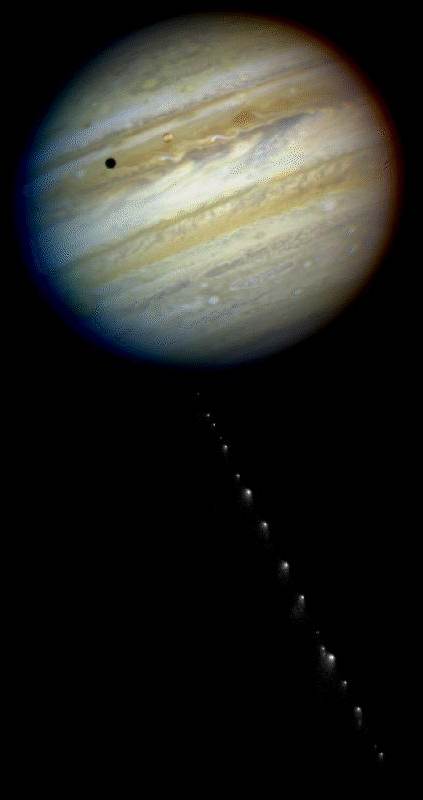
Photo Illustration of Comet P/Shoemaker-Levy 9 and the Planet Jupiter
This is a composite photo, assembled from separate images of Jupiter and comet P/Shoemaker-Levy 9, as imaged by the Wide Field & Planetary Camera-2 (WFPC-2), aboard NASA's Hubble Space Telescope (HST).
Jupiter was imaged on May 18, 1994, when the giant planet was at a distance of 420 million miles (670 million km) from Earth. This "true-color" picture was assembled from separate HST exposures in red, blue, and green light. Jupiter's rotation between exposures creates the blue and red fringe on either side of the disk. HST can resolve details in Jupiter's magnificent cloud belts and zones as small as 200 miles (320 km) across (wide field mode). This detailed view is only surpassed by images from spacecraft that have traveled to Jupiter.
The dark spot on the disk of Jupiter is the shadow of the inner moon Io. This volcanic moon appears as an orange and yellow disk just to the upper right of the shadow. Though Io is approximately the size of Earth's Moon (but 2,000 times farther away), HST can resolve surface details.
When the comet was observed on May 17, its train of 21 icy fragments stretched across 710 thousand miles (1.1 million km) of space, or 3 times the distance between Earth and the Moon. This required six WFPC exposures along the comet train to include all the nuclei. The image was taken in red light.
The apparent angular size of Jupiter relative to the comet, and its angular separation from the comet when the images were taken, have been modified for illustration purposes.
From July 16 through July 22, 1994, fragments of Comet P/Shoemaker-Levy 9 collided with Jupiter, with dramatic effect. This was the first collision of two solar system bodies ever to be observed. Shoemaker-Levy 9 consists of 20 discernable fragments with diameters estimated at up to 2 kilometers, which impacted the planet at 60 km/s. The impacts resulted in plumes many thousands of kilometers high, hot "bubbles" of gas in the atmosphere, and large dark "scars" on the atmosphere which have lifetimes at least on the order of weeks. Smaller bits and dust continue to impact the planet. Shoemaker-Levy 9 is gone, but as the Earth- and space-based images show, it did not go quietly. -- NASA
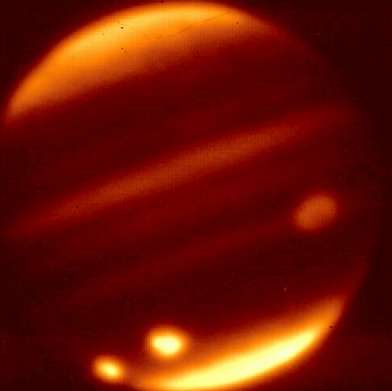
First Comet Impacts Captured by Keck Telescope
A single infrared image (3.5 mm, or microns) of Jupiter showing the bright polar caps and a familiar storm system. The brightest spot in the planet's southern hemisphere is the aftermath of comet fragment A, the dimmer spot at the bottom left is the aftermath of fragment C.
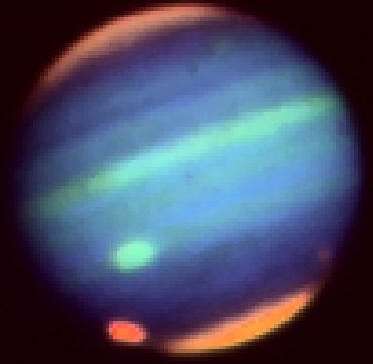
Early Impacts
This true-color IR image shows the aftermath of the impacts of several of the fragments of Shoemaker-Levy 9 with Jupiter. The image is a composite of three IR filters (2.3, 1.7, and 1.58 mm) which are shown here as red, green and blue.
The impact sites are the small red/orange spots at high southern latitudes: a bright one (A) visible rising on the limb to the left, and a much fainter one (D) setting on the right. Most of Jupiter's disk appears blue because is it brightest in the 1.58 micron filter where methane absorption is not significant. The great red spot actually appears green in this composite, as it quite prominent in the 1.7 micron wavelength range. Jupiter poles are capped with a high haze, appearing orange in this image. The polar 'hoods' are high enough to reflect sunlight in these long-wavelength methane absorption bands.
The image was taken between 2:06 and 2:18 UT on July 18, 1994, with the Ohio State Infrared Imaging Spectrometer (OSIRIS) at the 4-meter telescope of the Cerro Tololo Inter-American Observatory in Chile, by John Spencer (Lowell Observatory), Darren DePoy, Jay Frogel (Ohio State University), and Nick Schneider (CU/LASP).

Impact Sites in Infrared
This is a 2.07mm image of Jupiter taken on the NASA Infrared Telescope Facility, Mauna Kea, Hawaii, at 08:54 on July 21, 1994. The image was taken in a four second exposure using the IRTF's facility near infrared camera, NSFCAM.
Io, the closest of the jovian moons, can be seen crossing the planet in the northwest of the image (top right). The Great Red Spot is visible in the south east of the planet.
At the collision latitudes, the impact due to Fragment Q is just setting on the west. Just to the east of it, the R Fragment impact site shows up very brightly. Another four impact sites form a chain of spots behind R (N.B there is an additional fainter spot which may not be clearly visible).
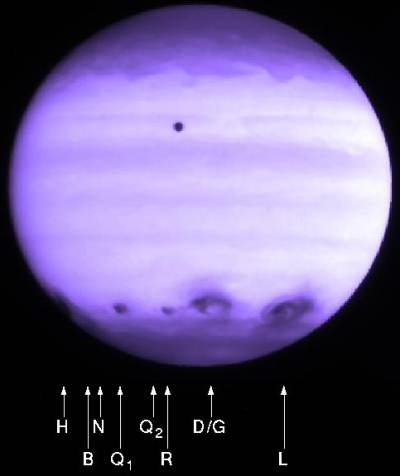
Hubble Ultraviolet Image
Ultraviolet image of Jupiter taken by the Wide Field Camera of NASA's Hubble Space Telescope. The image shows Jupiter's atmosphere at a wavelength of 2550 Angstroms after many impacts by fragments of comet Shoemaker-Levy 9. The most recent impactor is fragment R which is below the center of Jupiter (third dark spot from the right).
This photo was taken 3:55 EDT on July 21, about 2.5 hours after R's impact. A large, dark patch from the impact of fragment H is visible rising on the morning (left) side. Proceeding to the right, other dark spots were caused by impacts of fragments Q1, R, D and G (now one large spot), and L, with L covering the largest area of any seen thus far. Small dark spots from B, N, and Q2 are visible with careful inspection of the image.
The spots are very dark in the ultraviolet because a large quantity of dust is being deposited high in Jupiter's stratosphere, and the dust absorbs sunlight. Scientists will be able to track winds in the stratosphere by watching the evolution of these features. Jupiter's moon, Io, is the dark spot just above the center of the planet.

Galileo Watches Fragment W's Impact
These four images of Jupiter and the luminous night-side impact of fragment W of Comet Shoemaker-Levy 9 were taken by the Galileo spacecraft on July 22, 1994.
The spacecraft was 238 million kilometers (148 million miles) from Jupiter at the time, and 621 million kilometers from Earth. The spacecraft was about 40 degrees from Earth's line of sight to Jupiter, permitting this direct view. The images were taken at intervals of 2 1/3 seconds, using the green filter (visible light).
The first image, taken at an equivalent time to 8:06:10 Greenwich Mean Time (1:06 a.m. Pacific Daylight Time), shows no impact. In the next three images, a point of light appears, brightens so much as to saturate its picture element, and then fades again, seven seconds after the first picture. The location is approximately 44 degrees south as predicted; dark spots to the right are from previous impacts. Jupiter is approximately 60 picture elements in diameter.
The Galileo project, whose primary mission is the exploration of the Jupiter system in 1995 through 1997, is managed by the Jet Propulsion Laboratory for NASA's Office of Space Science.
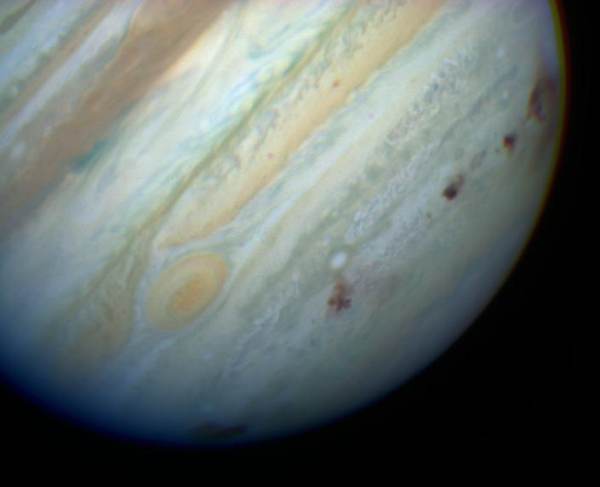
Hubble Color Image of Multiple Impact Sites
Image of Jupiter with NASA's Hubble Space Telescope's Planetary Camera. Eight impact sites are visible. From left to right are the E/F complex (barely visible on the edge of the planet), the star-shaped H site, the impact sites for tiny N, Q1, small Q2, and R, and on the far right limb the D/G complex. The D/G complex also shows extended haze at the edge of the planet. The features are rapidly evolving on timescales of days. The smallest features in this image are less than 200 kilometers across. This image is a color composite from three filters at 9530, 5550, and 4100 Angstroms.
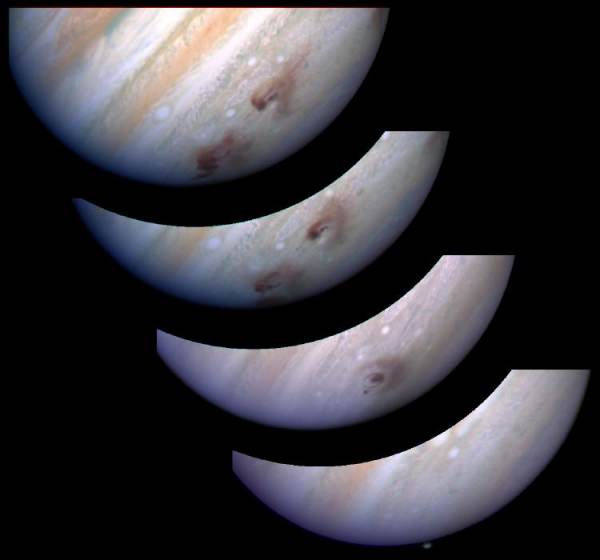
Hubble Tracks Evolution of the G Impact Site
This mosaic of WFPC-2 images shows the evolution of the G impact site on Jupiter. The images from lower left to upper right show: the impact plume at 07/18/94 07:38 UT (about 5 minutes after the impact); the fresh impact site at 07/18/94 at 09:19 UT (1.5 hours after impact); the impact site after evolution by the winds of Jupiter (left), along with the L impact (right), taken on 07/21/94 at 06:22 UT (3 days after the G impact and 1.3 days after the L impact); and further evolution of the G and L sites due to winds and an additional impact (S) in the G vicinity, taken on 07/23/94 at 08:08 UT (5 days after the G impact).
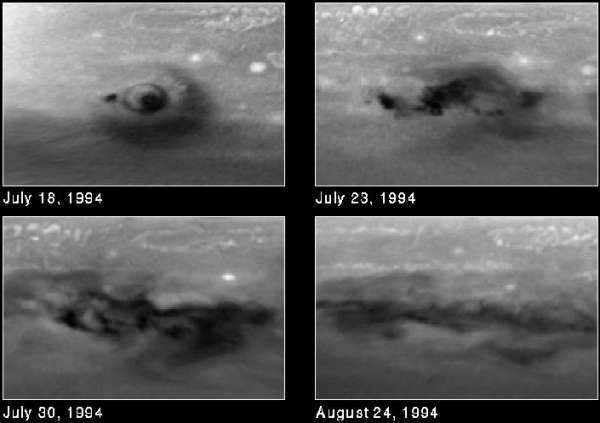
Month-Long Evolution of the D/G Impact Site
This series of snapshots, taken with NASA's Hubble Space Telescope, shows evolution of the comet P/Shoemaker-Levy 9 impact region called the D/G complex. This feature was produced by two nuclei of comet P/Shoemaker-Levy 9 that collided with Jupiter on 17 and 18 July 1994, respectively, and was later modified again by the impact of the S fragment on 21 July 1994.
Upper Left: This first image was taken about 90 minutes after the G impact on 18 July 1994. Nearly all of the structure in this image was created by the impact of fragment G, although a small dark spot to the left was the remainder of small fragment D that collided one day earlier. The explosion of the nucleus in Jupiter's atmosphere created the unique ring structure, which may be analogous to a "sonic boom" on earth. Though this structure is best seen for the G impact, it is not unique. Hubble reveals similar rings around several other fresh impact sites. They are all clear evidence for coherent outward motion of this wave phenomena.
Upper right: This second image, obtained on 23 July, shows that the Jovian winds have swept the material into a striking "curly-cue" structure.
Lower left, right: The structure seen in earlier views has disappeared rapidly in the images taken on 30 July and 24 August, respectively. Almost all of the changes between the images are due to Jupiter's east-west winds that play a key role in the dispersing of the dark material.
Hubble Space Telescope's high resolution will allow astronomers to continue to trace the impact debris as it is transported by the Jovian winds. This information promises to advance current understanding of the physics of Jupiter's atmosphere.
These black and white images were taken in near-ultraviolet light with the Wide Field Planetary Camera 2. They have been processed to correct for the curvature of Jupiter, so that the impact region appears flat, as if the viewer were hovering directly overhead. Each image is centered on -46 degrees latitude and 28 degrees. The north-south extent in the image spans from -26 to -66 deg. latitude and the east-west extent of the region spans +/- 30 degrees on either side of 28 degrees longitude.
 CosmicLight.com Home
CosmicLight.com Home